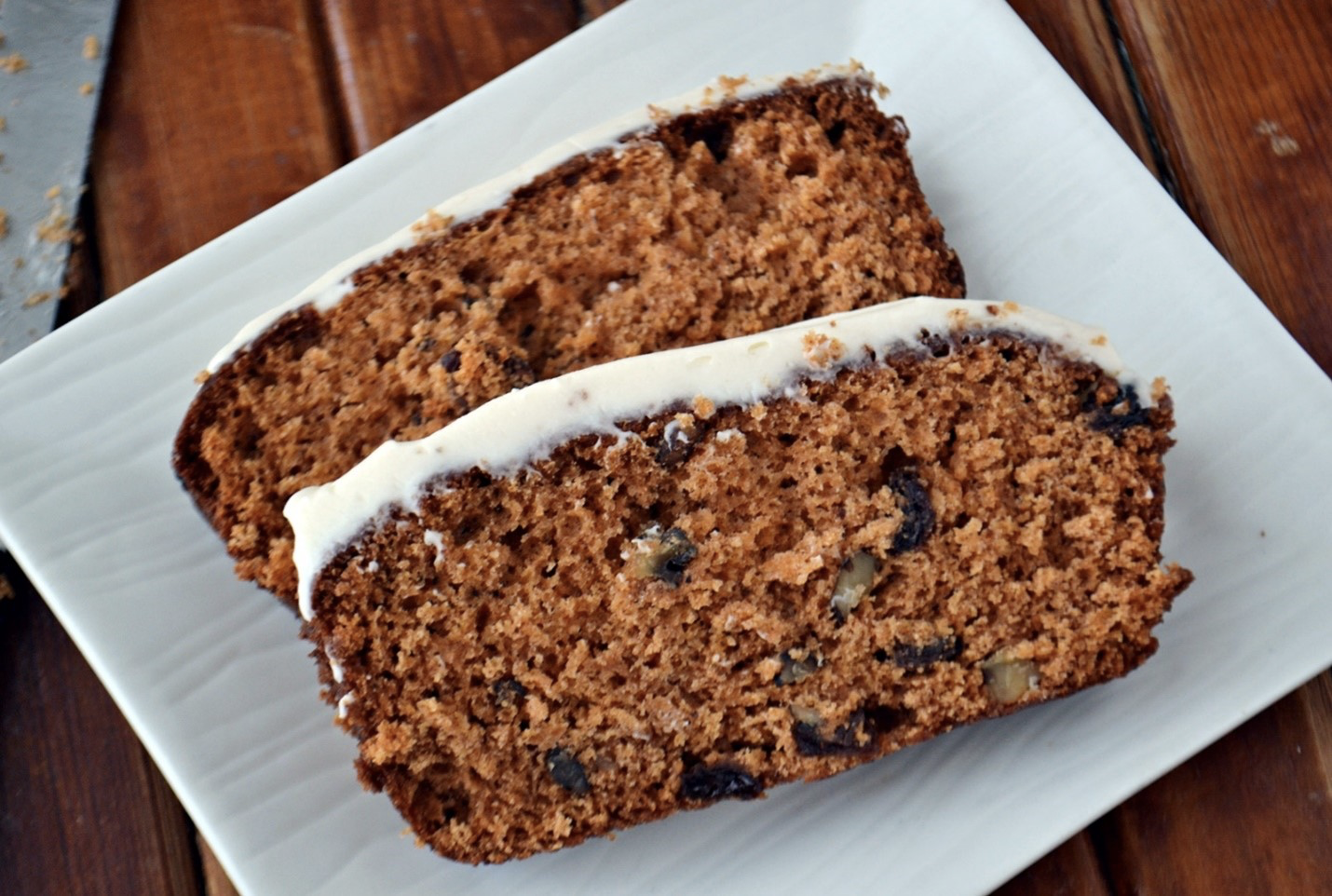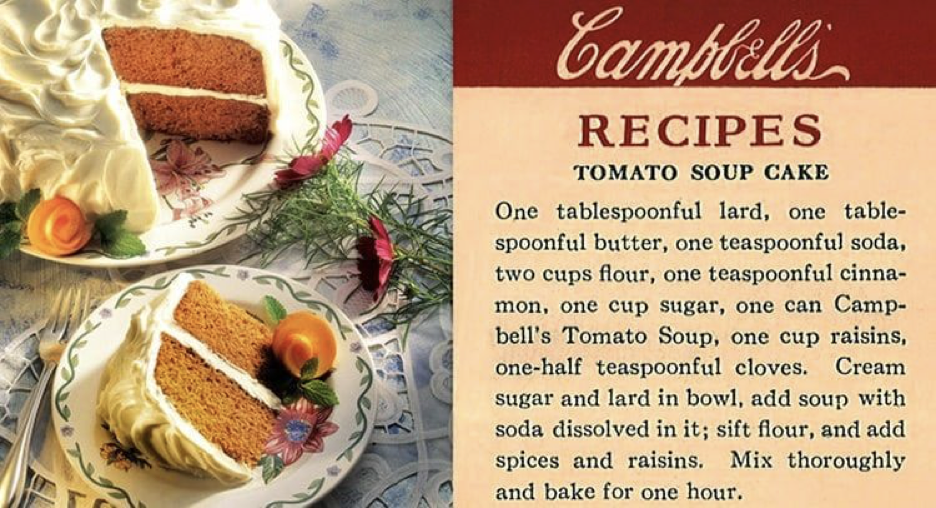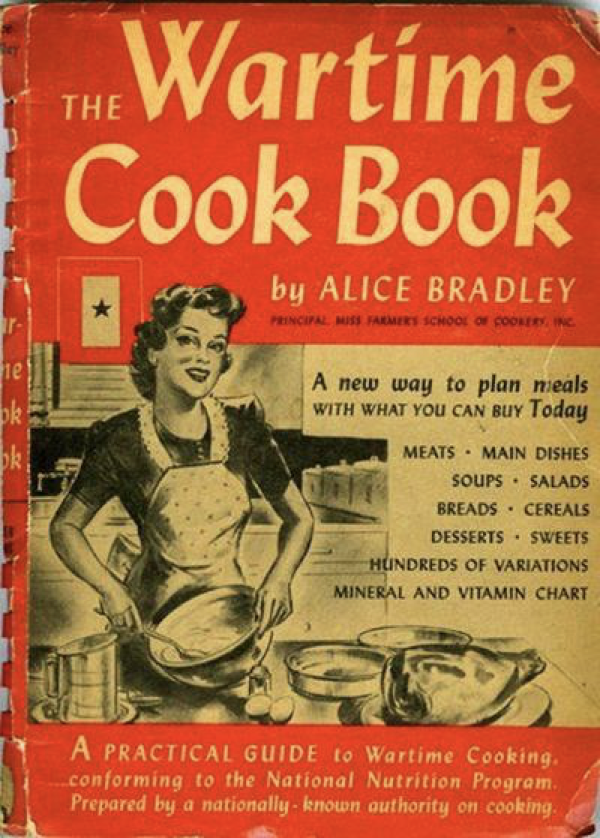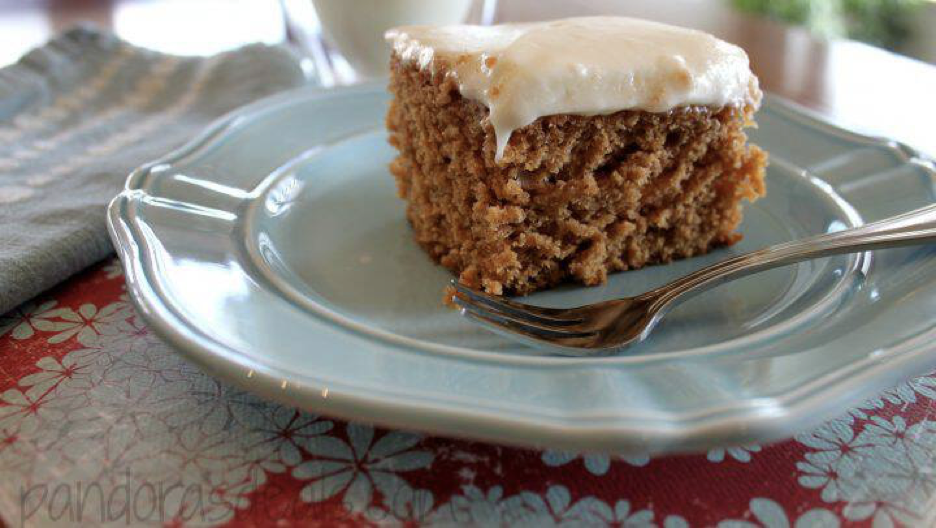“You Made This With WHAT!!??”
Our 10/23/2020 Cook’n Newsletter included an article I wrote on a vintage cake recipe using tomatoes. We received lots of feedback on this. Turns out, there are many Cook’n readers that either have made this cake themselves, or enjoyed it when their mothers and grandmothers made it.

Not long after the article appeared, we heard from Cook’n reader, Holly G., who said this: “I really enjoy the newsletter, especially all the back stories that go with the recipes. I love trying unusual and historic recipes and the idea of the tomato cake was intriguing. I was surprised though, when the original recipe calling for tomato soup was not also shared (or how to use soup instead of the tomatoes). Perhaps it can be shared in a future newsletter?”
I replied to her that I thought her suggestion was a great one and that I would absolutely do a follow-up article, with the focus being on using tomato soup rather than fresh or canned tomatoes. So here goes…

Bonnie McDowell, of the great site, QUAINT COOKING: FOR THE LOVE OF THE VINTAGE KITCHEN (www.quaintcooking.com), did her research, and has this to say about the history of this marvelous cake: “We have the 1920s to thank for the recipe that we know as Tomato Soup Cake. The recipe was created by the Campbell’s Soup Company to use with their condensed tomato soup. According to the company’s website, the first recipe appeared in an undated cookbook probably from the 1920s or possibly the 1930s.
“Later in the 1950s/1960s when boxed cake mixes came to be popular, we finally have the recipe that many now know—a spice cake typically finished off with a cream cheese frosting.”

History aside, the whole thing was a little confusing to me. I can see why folks would figure out how to include tomatoes in a cake—it’s a clever way to use them up. But who needs a way to use up tomato soup? So, what was the point in using tomato soup when making a cake?
I found my answer on a very interesting website, CIVIL WAR TALK (www.civilwartalk.com). I quote the information found on the site: “It turns out the recipe originally surfaced around the time of the Great Depression. It made a brief resurgence in popularity during the WWII era due to rationing and the need to once again become creative with the ingredients one had on hand.

“Most recipes for this type of cake do not contain eggs - which are an important binding and flavor component of cakes. In lieu of eggs, a can of tomato soup is added. Butter, another binding/flavor element to cake was also on short order for most variations of this recipe. Butter was another hard-to-find ingredient during wartime rationing and of course too costly for many during the Depression. While the recreated recipe (below) is made with sugar, often during WWII other sweeteners were utilized (such as maple syrup, molasses, honey, or sorghum) due to the rationing efforts.”
Thus, the mystery is solved. Certain ingredients not being available always bring out the creative cook in us, and the results can be awe-inspiring. And speaking of mystery, back in the day this cake was also called MYSTERY Cake. “You made this with WHAT!!??” I can just hear it…
If you’ve never made this cake, I’ve included the recipe. There are lots and lots of versions of it floating around, but according to food historians, this is the most typical.

1 cup sugar
2 tablespoons butter (or lard)
1 (10 3/4-ounce) can tomato soup
1 teaspoon baking soda
1 teaspoon baking powder
1 teaspoon vanilla extract (if available)
1 cup raisins (or 1 large Granny Smith apple chopped)
1 cup either chopped walnuts or pecans
2 teaspoons cinnamon
1/2 teaspoon nutmeg
2 cups flour
Directions:
Add Recipe to Cook'n
blog comments powered by Disqus

Not long after the article appeared, we heard from Cook’n reader, Holly G., who said this: “I really enjoy the newsletter, especially all the back stories that go with the recipes. I love trying unusual and historic recipes and the idea of the tomato cake was intriguing. I was surprised though, when the original recipe calling for tomato soup was not also shared (or how to use soup instead of the tomatoes). Perhaps it can be shared in a future newsletter?”
I replied to her that I thought her suggestion was a great one and that I would absolutely do a follow-up article, with the focus being on using tomato soup rather than fresh or canned tomatoes. So here goes…

Bonnie McDowell, of the great site, QUAINT COOKING: FOR THE LOVE OF THE VINTAGE KITCHEN (www.quaintcooking.com), did her research, and has this to say about the history of this marvelous cake: “We have the 1920s to thank for the recipe that we know as Tomato Soup Cake. The recipe was created by the Campbell’s Soup Company to use with their condensed tomato soup. According to the company’s website, the first recipe appeared in an undated cookbook probably from the 1920s or possibly the 1930s.
“Later in the 1950s/1960s when boxed cake mixes came to be popular, we finally have the recipe that many now know—a spice cake typically finished off with a cream cheese frosting.”

History aside, the whole thing was a little confusing to me. I can see why folks would figure out how to include tomatoes in a cake—it’s a clever way to use them up. But who needs a way to use up tomato soup? So, what was the point in using tomato soup when making a cake?
I found my answer on a very interesting website, CIVIL WAR TALK (www.civilwartalk.com). I quote the information found on the site: “It turns out the recipe originally surfaced around the time of the Great Depression. It made a brief resurgence in popularity during the WWII era due to rationing and the need to once again become creative with the ingredients one had on hand.

“Most recipes for this type of cake do not contain eggs - which are an important binding and flavor component of cakes. In lieu of eggs, a can of tomato soup is added. Butter, another binding/flavor element to cake was also on short order for most variations of this recipe. Butter was another hard-to-find ingredient during wartime rationing and of course too costly for many during the Depression. While the recreated recipe (below) is made with sugar, often during WWII other sweeteners were utilized (such as maple syrup, molasses, honey, or sorghum) due to the rationing efforts.”
Thus, the mystery is solved. Certain ingredients not being available always bring out the creative cook in us, and the results can be awe-inspiring. And speaking of mystery, back in the day this cake was also called MYSTERY Cake. “You made this with WHAT!!??” I can just hear it…
If you’ve never made this cake, I’ve included the recipe. There are lots and lots of versions of it floating around, but according to food historians, this is the most typical.

Tomato Soup Cake
Ingredients:
1 cup sugar
2 tablespoons butter (or lard)
1 (10 3/4-ounce) can tomato soup
1 teaspoon baking soda
1 teaspoon baking powder
1 teaspoon vanilla extract (if available)
1 cup raisins (or 1 large Granny Smith apple chopped)
1 cup either chopped walnuts or pecans
2 teaspoons cinnamon
1/2 teaspoon nutmeg
2 cups flour
Directions:
1. Preheat oven to 350 degrees and grease a tube cake pan (Bundt pan)
2. Stir the baking soda into the soup, then cream the butter, sugar and tomato soup together.
3. Add the remainder of the dry ingredients and mix until combined well.
4. Pour the batter into the cake pan and bake for 45 to 50 minutes or until a toothpick inserted in the middle comes out clean.
5. Let cool completely - about one hour, then remove from pan.
2. Stir the baking soda into the soup, then cream the butter, sugar and tomato soup together.
3. Add the remainder of the dry ingredients and mix until combined well.
4. Pour the batter into the cake pan and bake for 45 to 50 minutes or until a toothpick inserted in the middle comes out clean.
5. Let cool completely - about one hour, then remove from pan.
Recipe formatted with the Cook'n Recipe Software from DVO Enterprises.
Sources:
- www.newengland.com
- www.pinterest.com
- www.quaintcooking.com
- www.newcastlenews.com
- www.seemomclick.com
 Alice Osborne
Alice Osborne
DVO Newsletter Contributor since 2006
Email the author! alice@dvo.com
